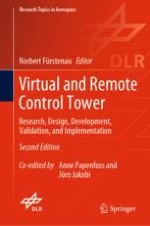2022 | OriginalPaper | Chapter
Planning Remote Multi-airport Control—Design and Evaluation of a Controller-Friendly Assistance System
Authors : Rodney Leitner, Astrid Oehme
Published in: Virtual and Remote Control Tower
Publisher: Springer International Publishing
Activate our intelligent search to find suitable subject content or patents.
Select sections of text to find matching patents with Artificial Intelligence. powered by
Select sections of text to find additional relevant content using AI-assisted search. powered by
